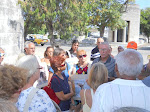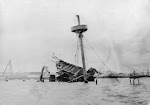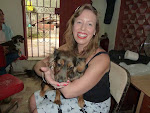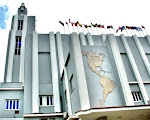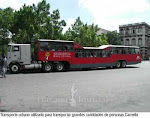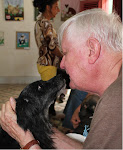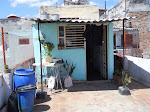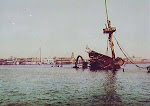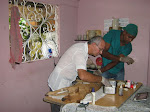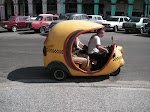Our Neighborhood Feud
I gave a little talk at a nearby Rotary Club this week, and I decided to call the talk, "A Cuban Scrapbook." While planning what to say, I felt I couldn't only talk about our work with the animals there. I knew I'd have to give them a little background on Cuban and US history and relations.
This year we mark 50 years since the US and Cuba broke off diplomatic relations. For the first 16 of those years there wasn't even an interests section for the other country in either capital.
With such a long freeze in relations, there's little wonder US citizens know very little about Cuba. And yet, before the current estrangement, the US and Cuba had a huge amount of interaction. At the time of the Castro Revolution (1959), the US owned 71% of all the business in Cuba and 76% of all its arable land. Pre-Castro, there were lots of Americans in Cuba and vice versa. Today it's a fight to travel between the two countries, and most people avoid the fight and don't even go.
So I sketched some of what it was like in the old days when the two countries were on good terms. We moved rapidly from 1492 to 1898, the Spanish Colony years--all except for 1762 when the British occupied a small part of Cuba. Later The Brits traded their Cuban holdings for Spain's part of Florida. (I wonder who got the better of that deal?)
Finally I got around to why I go to Cuba. That is to help Aniplant protect Cuban animals. Our little charity, The Aniplant Project (TAP), raises money to help Aniplant in its projects. TAP really got going in 2007, and the cooperation between TAP and Aniplant has been growing every year since then. Take a look at some then and now comparisons:
Item /Then/ Now
Sterilizations yr /624 / 3077
Headquarters /8th floor, broken elev/ restored 1st fl showplace
Isolation /no visits to US for years /2 visits in 2 years for Nora
Anesthesia meds /hospital cast off- outdated /fresh modern vet drugs
Electrocute strays /frequent /completely ended
We're not bragging, just trying to show how things are changing for Cuba's animals. Also the rapid growth of animal protection work is partly due to pent up demand from earlier years.
And for every dog or cat that is sterilized, the population of street animals is reduced by thousands in a few years.
Les Inglis
Saturday, April 30, 2011
Friday, April 22, 2011
Getting There
Getting There
Getting to Cuba for a US citizen isn't easy, but it can be done. Most people who want to go are shy about running the gauntlet of rules and regulations that form the US embargo of Cuba. But if you dig in and wade through the regulations, it all begins to make a little sense, and there are plenty of people to help you. First, Google the Office of Foreign Assets Control--OFAC will do. After you have passed though the rules covering travel to Cuba, it won't seem so difficult.
You'll need to fall under one of three main areas which allow travelers to go to Cuba--Humanitarian, Religious, and Research. These classes of travelers can affiliate with one of many organizations licensed by the US government to authorize your travel. Many people can find something in their background or education to link them to one of these three exception areas. Also, under recent changes promulgated by the Obama administration, educational trips for small groups are now being offered to promote people to people exchanges.
As a starting point, you'll use a travel agent licensed by the US government to arrange Cuba travel. I can direct you to a good one in Miami if you need it.
But every i must be dotted, and every t must be crossed if you go. In November 2009, two friends and I ran into a real problem as we arrived at Miami's airport for a week in Cuba. The desk man studied our papers for a long while and then told us we had the wrong kind of a Cuban visa, and we could not travel that day. It was unbelievable, having jumped all the hurdles we were told to. It seemed the licensee was a religious organization, and our Cuban visa was for tourists. Well, Cuba requires a special kind of visa for religious organizations, and it levies fines on airlines that don't get the paperwork right. It hadn't been our fault as we never intended to do religious work, but we couldn't go that day.
We were crestfallen after months of planning, preparations and driving 240 miles to Miami's airport. We slowly gathered up our luggage and went out toward the parking lot, hardly knowing what to do next. Before we got to the garage, I heard a man running after us and yelling for us to stop. It was the desk agent, and he told me he had found a loophole that would allow us to go after all. Back inside he adjusted our paperwork and passed us on through. I was so grateful, I offered him a nice tip, but he wouldn't take it--explaining he was just doing his job.
The reason for telling this little story is to illustrate how you have to be ready for adventure if you want to go legally. It's still a little like buying a ticket on a roller coaster.
As for those who would sidestep the formalities and fly to Havana through a third country, my advice is don't do it. Like the old saying, "It's not nice to fool Mother Nature." Don't mess around with Uncle Sam either.
Sometimes even when you try to do everything right, you can still run into trouble. Thankfully, we were helped by a ticket agent who must have known how important our trip was to us.
Les Inglis
Getting to Cuba for a US citizen isn't easy, but it can be done. Most people who want to go are shy about running the gauntlet of rules and regulations that form the US embargo of Cuba. But if you dig in and wade through the regulations, it all begins to make a little sense, and there are plenty of people to help you. First, Google the Office of Foreign Assets Control--OFAC will do. After you have passed though the rules covering travel to Cuba, it won't seem so difficult.
You'll need to fall under one of three main areas which allow travelers to go to Cuba--Humanitarian, Religious, and Research. These classes of travelers can affiliate with one of many organizations licensed by the US government to authorize your travel. Many people can find something in their background or education to link them to one of these three exception areas. Also, under recent changes promulgated by the Obama administration, educational trips for small groups are now being offered to promote people to people exchanges.
As a starting point, you'll use a travel agent licensed by the US government to arrange Cuba travel. I can direct you to a good one in Miami if you need it.
But every i must be dotted, and every t must be crossed if you go. In November 2009, two friends and I ran into a real problem as we arrived at Miami's airport for a week in Cuba. The desk man studied our papers for a long while and then told us we had the wrong kind of a Cuban visa, and we could not travel that day. It was unbelievable, having jumped all the hurdles we were told to. It seemed the licensee was a religious organization, and our Cuban visa was for tourists. Well, Cuba requires a special kind of visa for religious organizations, and it levies fines on airlines that don't get the paperwork right. It hadn't been our fault as we never intended to do religious work, but we couldn't go that day.
We were crestfallen after months of planning, preparations and driving 240 miles to Miami's airport. We slowly gathered up our luggage and went out toward the parking lot, hardly knowing what to do next. Before we got to the garage, I heard a man running after us and yelling for us to stop. It was the desk agent, and he told me he had found a loophole that would allow us to go after all. Back inside he adjusted our paperwork and passed us on through. I was so grateful, I offered him a nice tip, but he wouldn't take it--explaining he was just doing his job.
The reason for telling this little story is to illustrate how you have to be ready for adventure if you want to go legally. It's still a little like buying a ticket on a roller coaster.
As for those who would sidestep the formalities and fly to Havana through a third country, my advice is don't do it. Like the old saying, "It's not nice to fool Mother Nature." Don't mess around with Uncle Sam either.
Sometimes even when you try to do everything right, you can still run into trouble. Thankfully, we were helped by a ticket agent who must have known how important our trip was to us.
Les Inglis
Sunday, April 10, 2011
El Acuario
El Acuario
You couldn't pay me to go to Sea World. This attraction that offers performing dolphins and whales is iconic among animal rights folks as a place to hate. And why not? They capture sea mammals and teach them to do tricks for the paying customers. Once made into a Sea World performer, a dolphin or whale will never know free swimming again and will always be constrained to circle endlessly in what amounts to large swimming pools. And, after a few weeks or months of this captivity, these animals lose their ability to hunt for food. That is the final insult. Even if we freed them all, they'd die in the wild.
But we decided to visit El Acuario in Miramar near Havana--more to understand what it is than to patronize exploitation. El Acuario is right next to the sea, and, during recent hurricanes, storm surges had invaded the property, damaged some buildings and caused the escape of some performing dolphins, probably followed by their starving to death. Restorations of the buildings were underway, but moving slowly--it had been years since the hurricanes. We wandered the grounds waiting for show time, and we stared at the non-performing captives--turtles, sea birds, and other small animals.
When it came time to be seated for the show, we had our choice of seats, and we moved to the center of a circular bleacher structure, about half way up to the top. There, before us, was a large, oval shaped pool with gates controlling access to two smaller pools, one on either side of the main pool. Large, flat stage areas were in front of and behind the large pool where the trainers did their work. There were two male and two female trainers and plenty of buckets of fish used by the trainers as rewards for tricks well done.
I commented to Nora that the dolphins seemed happy, and she wisely told me not to confuse the calmness that comes with resignation with contentment. Mulling that over, I thought how sad not to be able to swim in a straight line for more than a few yards. And how sad to be fed from a bucket instead of hunting and chasing your dinner. How defeated a new performer must be when he senses he'll never again explore a new part of the sea.
The show was professional and entertaining, the long days of training to get them to do their tricks was evident if you thought about it. But in El Acuario as well as in Sea World the show is designed to keep you from thinking about the captivity, the resignation, or their loss of freedom.
Thankfully El Acuario has no orcas or killer whales. It's quite enough to think about these exploited dolphins, prisoners of animal exploitation. As the show ended, we were invited to a small group that gathered on one of the stages to pet two dolphins who beached themselves so we could pet them. I wondered what they thought of us as we petted them, and even talked to them.
Les Inglis
You couldn't pay me to go to Sea World. This attraction that offers performing dolphins and whales is iconic among animal rights folks as a place to hate. And why not? They capture sea mammals and teach them to do tricks for the paying customers. Once made into a Sea World performer, a dolphin or whale will never know free swimming again and will always be constrained to circle endlessly in what amounts to large swimming pools. And, after a few weeks or months of this captivity, these animals lose their ability to hunt for food. That is the final insult. Even if we freed them all, they'd die in the wild.
But we decided to visit El Acuario in Miramar near Havana--more to understand what it is than to patronize exploitation. El Acuario is right next to the sea, and, during recent hurricanes, storm surges had invaded the property, damaged some buildings and caused the escape of some performing dolphins, probably followed by their starving to death. Restorations of the buildings were underway, but moving slowly--it had been years since the hurricanes. We wandered the grounds waiting for show time, and we stared at the non-performing captives--turtles, sea birds, and other small animals.
When it came time to be seated for the show, we had our choice of seats, and we moved to the center of a circular bleacher structure, about half way up to the top. There, before us, was a large, oval shaped pool with gates controlling access to two smaller pools, one on either side of the main pool. Large, flat stage areas were in front of and behind the large pool where the trainers did their work. There were two male and two female trainers and plenty of buckets of fish used by the trainers as rewards for tricks well done.
I commented to Nora that the dolphins seemed happy, and she wisely told me not to confuse the calmness that comes with resignation with contentment. Mulling that over, I thought how sad not to be able to swim in a straight line for more than a few yards. And how sad to be fed from a bucket instead of hunting and chasing your dinner. How defeated a new performer must be when he senses he'll never again explore a new part of the sea.
The show was professional and entertaining, the long days of training to get them to do their tricks was evident if you thought about it. But in El Acuario as well as in Sea World the show is designed to keep you from thinking about the captivity, the resignation, or their loss of freedom.
Thankfully El Acuario has no orcas or killer whales. It's quite enough to think about these exploited dolphins, prisoners of animal exploitation. As the show ended, we were invited to a small group that gathered on one of the stages to pet two dolphins who beached themselves so we could pet them. I wondered what they thought of us as we petted them, and even talked to them.
Les Inglis
Saturday, April 2, 2011
It Just Doesn't Get Better Than This
It Just Doesn't Get Better Than This
They say that men and dogs formed their historic symbiotic alliance shortly after men congregated in communities. More adventurous wolves would set aside their fear of men and approach them in their refuse dumps. They had so much to give to each other that a historic cooperation of the two species formed and grew rapidly. Dogs provided men with security, protection, and hunting cooperation and received food from mankind's leftovers. Both species offered the other faithful commitment and received companionship, the most valuable gift of all.
Now, thousands of years later the bonding has continued and permeates most of our lives. Hector, a Cuban boy in the early grades, walks home in his school uniform and comes across a stray puppy, pausing to play with him. When he knows he must get on home, he walks off, but the puppy follows, crossing streets wisely only when Hector does. By the time they get to Hector's house, the dog has a name, Coco, after Hector's best friend who moved away months ago.
"Can I please keep him, Mom? Please?" We all know how those conversations go. This mom loves her son enough to allow Coco into the family in spite of the extra cleaning work he'll cause and the need to share out the family's food a little further. She knows what the dog can add to Hector's life.
She has given him a great gift--something far better than a toy soldier or a bike. That gift will last longer in Hector's life than even Coco will. In no time Hector will learn what a true friend his dog is. He'll learn loyalty, dedication, companionship, and responsibility, and sadly, even separation and loss someday when Coco dies. But Hector will replace Coco with other dogs and enjoy their company his whole life.
This story is repeated millions of time a year. It took place in Cuba, but something like it is happening everywhere, everyday. It has happened to me perhaps 20 times in a long life, and I can still feel the presence of dogs long gone while I love the ones still here. Sometimes when I put my arms around Peachy, our big Golden Doodle as she walks by my chair, I feel Boy, a German Shepherd who used to sit next to me on our back porch stairs. Even though Boy left us twenty years ago, it's all still there, the love, the feelings, the happiness.
I couldn't imagine a life without dogs. I hope I never have to.
Les Inglis
They say that men and dogs formed their historic symbiotic alliance shortly after men congregated in communities. More adventurous wolves would set aside their fear of men and approach them in their refuse dumps. They had so much to give to each other that a historic cooperation of the two species formed and grew rapidly. Dogs provided men with security, protection, and hunting cooperation and received food from mankind's leftovers. Both species offered the other faithful commitment and received companionship, the most valuable gift of all.
Now, thousands of years later the bonding has continued and permeates most of our lives. Hector, a Cuban boy in the early grades, walks home in his school uniform and comes across a stray puppy, pausing to play with him. When he knows he must get on home, he walks off, but the puppy follows, crossing streets wisely only when Hector does. By the time they get to Hector's house, the dog has a name, Coco, after Hector's best friend who moved away months ago.
"Can I please keep him, Mom? Please?" We all know how those conversations go. This mom loves her son enough to allow Coco into the family in spite of the extra cleaning work he'll cause and the need to share out the family's food a little further. She knows what the dog can add to Hector's life.
She has given him a great gift--something far better than a toy soldier or a bike. That gift will last longer in Hector's life than even Coco will. In no time Hector will learn what a true friend his dog is. He'll learn loyalty, dedication, companionship, and responsibility, and sadly, even separation and loss someday when Coco dies. But Hector will replace Coco with other dogs and enjoy their company his whole life.
This story is repeated millions of time a year. It took place in Cuba, but something like it is happening everywhere, everyday. It has happened to me perhaps 20 times in a long life, and I can still feel the presence of dogs long gone while I love the ones still here. Sometimes when I put my arms around Peachy, our big Golden Doodle as she walks by my chair, I feel Boy, a German Shepherd who used to sit next to me on our back porch stairs. Even though Boy left us twenty years ago, it's all still there, the love, the feelings, the happiness.
I couldn't imagine a life without dogs. I hope I never have to.
Les Inglis
Subscribe to:
Posts (Atom)

